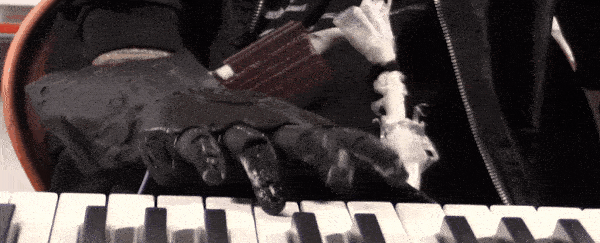In recent years we've seen mind-blowing advances in prosthetics, and even though most of these are still largely confined to the lab, bionic limbs people can control with their minds are definitely coming.
But fine motor control is still something most prosthetic arm users can only dream about. Now researchers at Georgia Institute of Technology have designed an entirely new type of prosthetic with individual finger movements - and it doesn't even rely on brain sensors.
The inspiration for this device came from the team's collaboration with an amputee whom they already turned into a 'cyborg drummer' back in 2014.
Five years ago, aspiring musician Jason Barnes from Georgia was electrocuted by high-voltage power lines while cleaning a rooftop vent hood at the restaurant he was working at. After a near-death experience, Barnes survived - but lost his right arm just below the elbow.
That didn't stop him from drumming, however. Barnes taped a drumstick to his arm and kept practicing, soon earning a spot at the Atlanta Institute of Music.
Using a basic self-designed drumming prosthetic, he kept going - until he was put in touch with roboticist Gil Weinberg at Georgia Tech, who built a robotic prosthesis with not one, but two drumsticks.
One of the drumsticks Barnes can control with his own arm muscles through electromyography (EMG) sensors that send the impulses between his arm and the prosthetic.
Additionally, the prosthetic has different hand modes that can be switched with the press of a button - technology that's common in a lot of prostheses available today.
But the additional stick really takes his drumming performance to the next level - it "improvises" based on the music being played.
"The second drumstick has a mind of its own," Weinberg explained in 2014. "The drummer essentially becomes a cyborg. It's interesting to see him playing and improvising with part of his arm that he doesn't totally control."
We've got one of his drumming performances in a bonus video down below.
Now, Weinberg and his team have gone ever further, giving Barnes individual finger control for the first time since his loss of arm - and it's so fine he can even hit individual piano keys.

What's most crazy about this new prosthesis is the technology behind it. Just like the cyborg drumming arm, this piano hand doesn't rely on brain sensors, but communicates with Barnes's muscles directly.
It relies on ultrasound - the same tech used to see babies in the womb - and an algorithm that translates the muscle twitches into finger movements based on what Barnes is trying to do.
This is possible because some of our finger movement is controlled by muscles that go all the way up to the elbow - just try waving your ring finger up and down while watching your arm and you can see the muscles shift under the skin.
The team at Georgia Tech is excited by how well the fingers work, and think the ultrasound tech could be able to do other fine motor activities.
"If this type of arm can work on music, something as subtle and expressive as playing the piano, this technology can also be used for many other types of fine motor activities such as bathing, grooming and feeding," says Weinberg, adding it could also go the other way, letting people remotely control robotic arms by simply moving their fingers.
"It's completely mind-blowing," says Barnes.
"This new arm allows me to do whatever grip I want, on the fly, without changing modes or pressing a button. I never thought we'd be able to do this."
You can watch the piano-playing action in the Georgia Tech video below:

And here is Barnes's awesome three-stick drumming performance in a video from a Robotic Concert in Shanghai, China last year:

